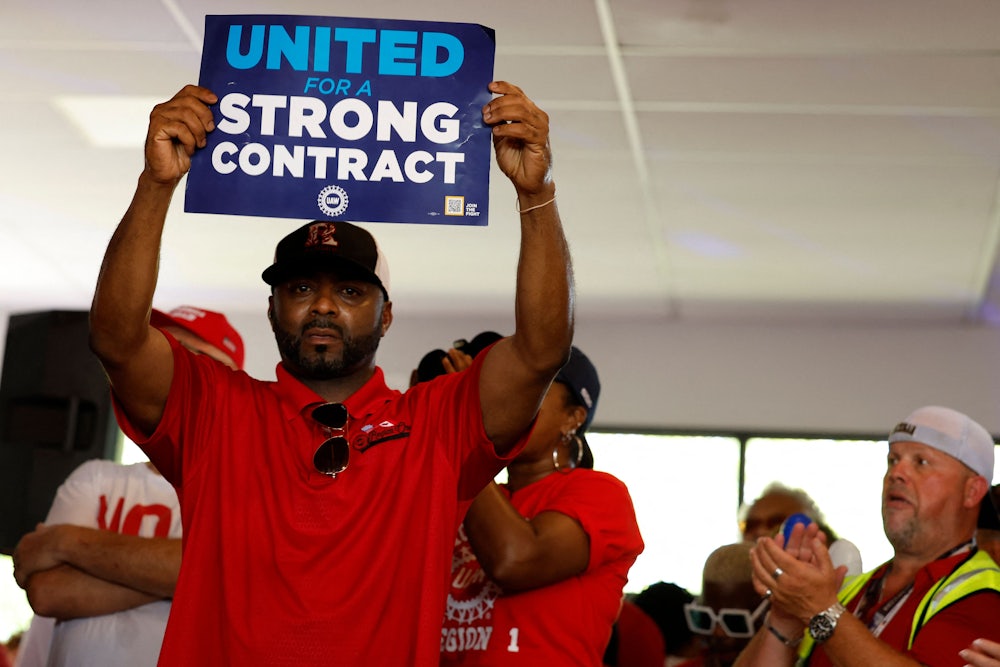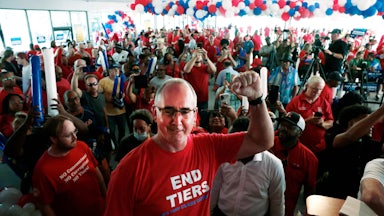Last March, when Michigan became the first state in 58 years to repeal a right-to-work law, it was yet another sign that public support for labor unions is on the rise. During the past couple of years, unions’ public approval ratings have been higher than in half a century. Now a new study by two economists for the Federal Reserve Board presents what may be the most comprehensive case ever that right-to-work laws beggar union and nonunion workers alike.
A right-to-work law is a state law that bars unions from collecting fees from union nonmembers to cover their share of collective bargaining costs. In a union shop, union nonmembers are covered by the same contract as union members and have the same rights. Right-to-work laws therefore give a worker a strong economic incentive to quit the union and become a free rider. The result is, typically, shrinking union membership. One recent study of five states that went right-to-work starting in 2012 found that unionization rates there fell 4 percent and that in highly unionized industries, union density was nearly 20 percent lower in right-to-work states than in other states. This is why business organizations almost always favor right-to-work laws.
During the past decade, right-to-work has been on a roll. States were barred by federal statute from passing right-to-work laws until passage (over President Harry Truman’s veto) of the anti-union Taft-Hartley Act in 1947. Through the 1950s, 18 states, mostly in the conservative strongholds of the South and the West, passed right-to-work laws. After that, the spread of right-to-work slowed to a trickle, but it picked up again after 2010 as Republicans expanded their reach into state legislatures. The first state to pass such a law was Indiana, which had previously repealed its earlier right-to-work statute in 1965 and was the last one to do so before Michigan. In 2012, Indiana reinstated right-to-work. Today, 27 states are right-to-work.
In 2018, the Supreme Court’s ruling in Janus v. AFSCME Council 31 effectively compelled all unions that represent government workers to operate on a right-to-work basis. This was potentially a heavy blow to the labor movement because membership is five times greater in public-sector unions (33 percent) than in private-sector unions (6 percent). But thus far public employee union membership has remained surprisingly steady—a sign, perhaps, that government unions have more resolve than private-sector unions.
Now the tide may be turning. Michigan’s reversal on right-to-work followed passage last November of a state constitutional amendment barring the state legislature from imposing right-to-work. In 1965, the same year Indiana repealed right-to-work, unions’ approval rating was 71 percent. After that it went into steep decline, bottoming out at 48 percent in 2009. But then it began to climb, reaching 71 percent again in 2022 and ticking down to a still very impressive 67 percent this year.
Intriguingly, unions’ image started to improve right around the time Republican state legislatures stepped up their efforts to kill off labor unions, not only through right-to-work legislation but also through other state laws passed in Wisconsin and elsewhere. Wisconsin Governor Scott Walker, with a $20 million war chest, briefly looked unbeatable in the 2016 Republican primaries. But his kill-the-unions message proved far more popular with Republican donors than with Republican voters, and Walker was out of the race well before Donald Trump entered it. Candidate Trump signaled to union workers that he was on their side, but President Trump was every bit as hostile to labor as Walker would have been, and he supported legislation to impose right-to-work rules nationwide. President Joe Biden, by contrast, supports the Protecting the Right to Organize, or PRO, Act, which, among other things, would eliminate state right-to-work laws, restoring the status quo before Taft-Hartley.
The new Fed study does an excellent job explaining the damage done to workers by right-to-work laws. According to the Fed report, previous studies of whether right-to-work lowered wages came to contradictory conclusions (even though it’s well established that union workers outearn nonunion workers). But the Fed study concludes that right-to-work lowers wages, on average, by $1,900, or 4 percent of the average wage. (Another report, also released this month, reaches basically the same conclusion.)
But the Fed report doesn’t stop by reporting pay disparities; it broadens the question to other measures of economic well-being. Workers in right-to-work states are less likely than workers in other states to receive a promotion, even though they’re more likely to ask for one. Workers in right-to-work states are likelier to quit (though marginally less likely to get laid off), a useful indicator of confidence about finding another job. Workers in right-to-work states are less likely to get health insurance through work. They’re also less likely to own a credit card, less likely to have a good credit rating, and less likely to report that they’re handling their finances comfortably.
Will the PRO Act ever pass? It’s sobering to contemplate that the last time public approval for labor unions was 71 percent, in 1965, President Lyndon Johnson also had a public approval rating of 71 percent. Before the year was out, Johnson would sign into law a string of Great Society programs, including the Voting Rights Act; the law creating Medicare and Medicaid; the law creating the National Endowment for the Arts and the National Endowment for the Humanities; the Elementary and Secondary Education Act, which for the first time committed the federal government to large-scale funding for K-12 public schools; and the Immigration and Nationality Act, which reversed a half-century of nativist restrictions on immigration. It was the most astonishing string of domestic policy achievements since President Franklin Roosevelt’s New Deal, and it’s never been matched since.
Even so, Johnson didn’t sign into law his variation on the PRO Act, which would have (among other things) eliminated state right-to-work laws. Johnson’s labor bill cleared the House but was stopped in the Senate by a filibuster led by Senator Everett Dirksen of Illinois, the Republican minority leader often remembered warmly as a conservative friend of civil rights. He was not a conservative friend of labor rights, and in this instance, he made common cause with the same Southern Democrats who opposed civil rights. “You wouldn’t do that to me,” Johnson told Dirksen. But he did.
There’s no chance that the Voting Rights Act, Medicare, Medicaid, the National Endowments of the Arts and the Humanities, the Elementary and Secondary Education Act, and especially the Immigration and Nationality Act could clear Congress if they came up for a vote today. And there’s little chance that the PRO Act can clear this Senate because Senators Kyrsten Sinema, an independent, and Mark Kelly, a Democrat, of Arizona, will likely oppose it. (Surprisingly, Senator Joe Manchin, the West Virginia Democrat, has signed onto the PRO Act.) But if the tangible benefits of passing the PRO Act can be made clearer to voters, and especially to the working-class voters whom Democrats are struggling to corral, perhaps the impossible will become possible. If it happens under President Joe Biden, the forty-sixth president will be able to say he achieved what LBJ couldn’t, even during liberalism’s last golden age.










